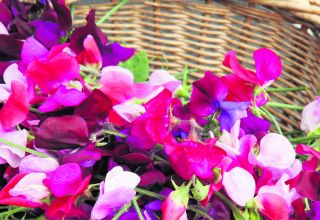
This fast-growing South American plant is known for its unique blooms but they are very demanding in terms of sun and water.
Brugmansias are famously also known as angel’s trumpets. These tender tropical shrubs or small trees are grown for their highly fragrant flowers. White, red or pastel shades of pink, orange or yellow, the large, flared trumpets hang from the branches throughout summer. The flowers can grow to an impressive size – up to a foot long – and waft their heady perfume far and wide, especially on warm evenings.
Brugmansias come from tropical regions of South America. Here, most species are pollinated by moths, which is why the flowers are noticeably more fragrant in the evening. Only one species, Brugmansia sanguinea, has no fragrance, as the flowers are pollinated in the wild by hummingbirds, which are attracted by the bright red colour of the flowers.
The best place to plant angel’s trumpet is in a spot that boasts full sun. However, in especially hot or dry environments, it can stand a bit of shade, especially during the warmer afternoon hours. Angel’s trumpet needs between six and eight hours of sunlight daily to thrive and produce the best blooms.
The good news is the UK has the perfect humidity and temperature to support brugmansai growth but the more challenging part is overwintering the plant when temperatures dip below freezing.
Angel’s trumpet needs six to eight hours of full sunprofuse blooming. As long as the plant receives a fair amount of sun, it will produce blooms all summer long and grow several feet in just one season.
With its large, scented, trumpet flowers, hanging in abundance from its branches all summer, this tropical shrub or small tree is a real showstopper. Grow it in a large container outdoors in summer or indoors all year. Protect it from winter cold, and water liberally and daily throughout the growing season.
Plants can flower very abundantly over a long period, especially more mature specimens. But they do need lots of water and feeding throughout the growing season, and must be kept above 7–10˚C (45–50˚F) in winter.
Brugmansias are often confused with datura, which have similar trumpet flowers. However, with brugmansias the flowers hang downwards and the main stem and branches are woody.
How and what to buy
You can buy a selection of brugmansias from online suppliers, particularly those specialising in exotic or conservatory plants. Some garden centres may also stock them. Plants are usually available from late winter to summer, in pots from nine cms diameter upwards. Small plants are usually cheaper, but some may not bloom for a year or so, until they reach flowering size.
Before buying, make sure you have somewhere to keep your brugmansia over winter. Most need a temperature of at least 7–10˚C (45–50˚F). Brugmansias are vigorous growers and can reach well over 2m (6ft) tall, so you need plenty of space to accommodate them. Still, you can prune them at the end of the season.
The period of time when an individual plant is in active growth will depend on the local climate and light levels, and can vary between different plants, although it is broadly from spring to autumn.
Also be prepared to water your brugmansia at least once a day in summer – they are very thirsty plants. They need a weekly feed to boost flowering too. But in return they should give you a spectacular display of large, exotic, richly scented flowers all summer long.
Plant brugmansias individually in large containers, to stand either indoors all year or outdoors in summer. You can also plant them temporarily into borders over the summer, then re-pot them and bring them indoors in autumn.
Indoors, brugmansias need bright light, such as in a conservatory or beside a large sunny window, or in a heated greenhouse.
Outdoors in summer, give them a warm, sheltered spot, in partial shade or sun. Planting in partial shade means they should dry out less quickly.
They do best in locations that receive plenty of summer rainfall, as they dislike dry conditions. In regions that have very low rainfall in summer, or in very free-draining soil, you will need to water them particularly well.
Brugmansias make eye-catching focal points, and suit a wide range of garden styles, formal or informal, traditional or contemporary. These include exotic-style gardens, sheltered urban courtyards or patios, Mediterranean gardens, and more. They work well with other exotic plants, including dahlias.
Light
The best place to plant angel’s trumpet is in a spot that boasts full sun. However, in especially hot or dry environments, it can stand to have a bit of shade, especially during the warmer afternoon hours. Angel’s trumpet needs between six and eight hours of sunlight daily to thrive and produce the best blooms.
Soil
Angel’s trumpet is perhaps the least picky about its soil. It can exist happily in almost any blend, from sand and clay to loam and richly organic mixtures. The most crucial factor is the soil’s drainage.
Brugmansia does not like to be waterlogged but prefers consistently moist soil, so there’s a delicate balance. If growing in pots, this plant will typically do well in a potting mix designed for azaleas and camellias. If planted in nutrient-poor soil, be prepared to fertilise the plant often, as brugmansia is a heavy feeder.
Types of brugmansia
Brugmansia species have distinctive, drooping trumpet-shaped flowers, and most produce sweetly-scented blooms that open at night. The most significant difference between each species is bloom colour.
- Brugmansia suaveolens: this cream-coloured blooming plant is one of the most popular species.
- Brugmansia aurea: This plant sports yellow blooms and is often called a golden angel’s trumpet. It’s native to Ecuador and Venezuela.
- Brugmansia sanguine: This red-flowering species has no scent and in its native area is commonly pollinated by long-billed hummingbirds.
- Brugmansia vulcanicola: Native to the Andean Mountains ranging from Colombia to Ecuador, this salmon-coloured specimen is considered the rarest brugmansia. Its ‘Rosa Lila’ hybrid is a rose-coloured cultivar.
- Brugmansia arborea: This plant features the shortest angel’s trumpet flowers, often a whiter cream colour than most.
- Brugmansia versicolor: This species from Ecuador has the largest flowers in pale apricot.
- Brugmansia ‘Cypress Gardens’: Best for containers, the young plants often flower at three feet in height with dozens of white flowers that fade to a light salmon with age.
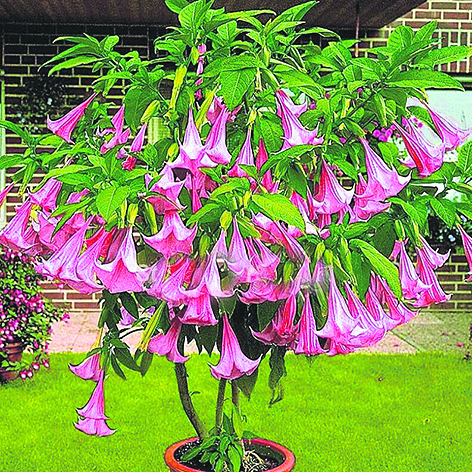
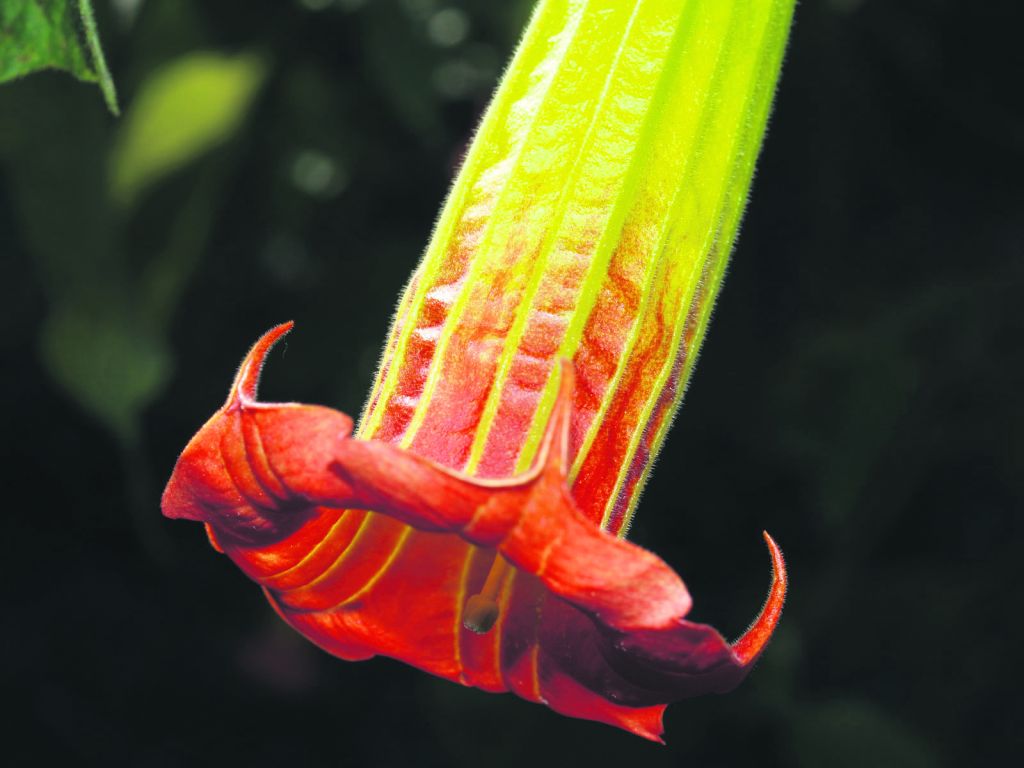
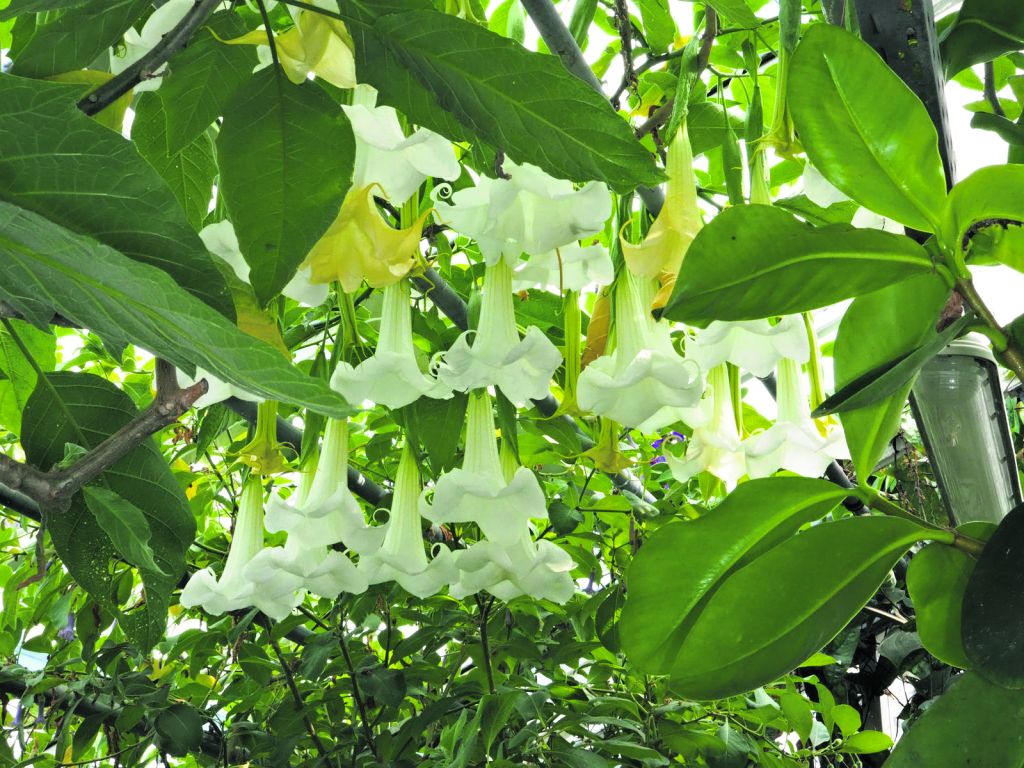
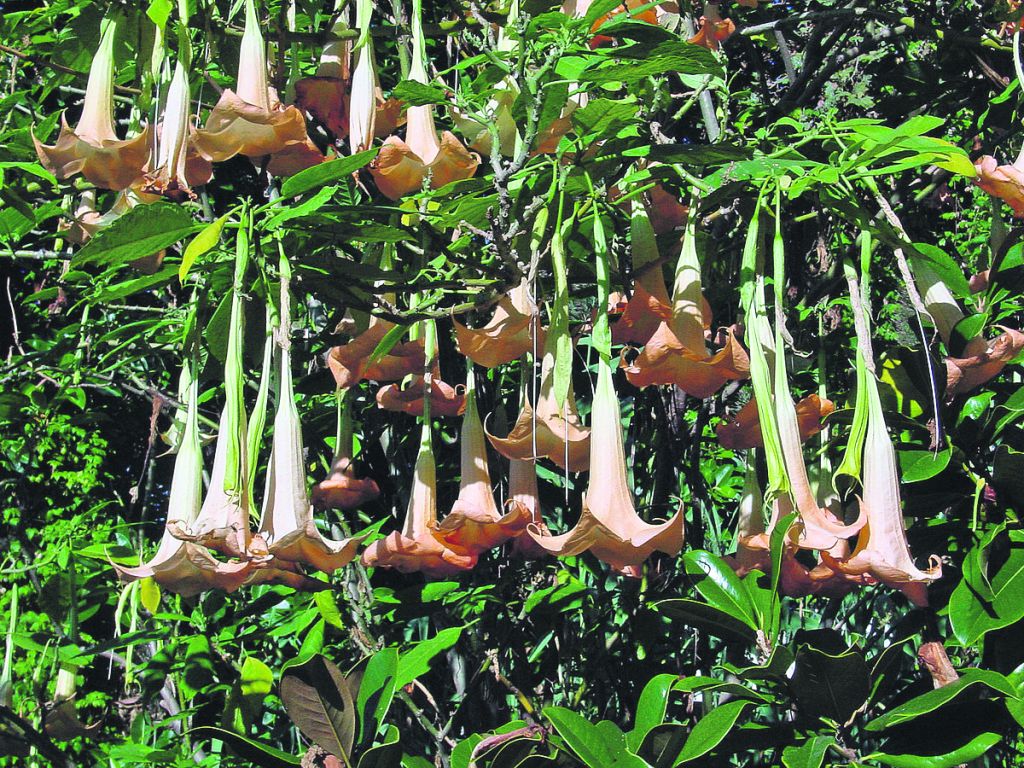
What’s the difference between brugmansia and datura?
Brugmansia and datura are interchangeably called angel’s trumpets. They look similar, come from the Solanaceae family, and are toxic plants. However, brugmansia plants can grow up to 20 feet tall with larger, pendulous flowers that face downward, lasting longer.
The datura plant only grows up to four feet tall; its trumpeting flowers face upward; and its round, spiny seed pods self-sow easily. Brugmansia has smooth, elongated seed pods that do not self-sow. Datura flowers are usually white or white and purple, while brugmansia flowers are white, yellow, or peach.
Brugmansia – the key facts
- The show-stopping hanging trumpet-shaped flowers of brugmansia (also known as angel’s trumpet) make it a delight for any garden.
- Grown either as a woody shrub or small tree, angel’s trumpet is a tropical plant that does best with full sun and ample water. Brugmansia is best planted in midspring when outdoor temperatures no longer drop below 50˚F at night.
- The plant will grow quickly, often between 24 to 36 inches a year.
- All parts of the angel’s trumpet plant are toxic to humans, dogs, and cats.
- Almost any soil will suit it.
- Needs moderate to warm temps; should not be kept outdoors lower than 50˚F.

